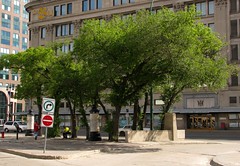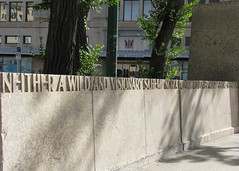Location: Memorial Boulevard at Colony Street (Map)
Unveiled: October 1955
Artist: Roy Sellors
The triangular piece of land at Colony and Memorial was given to the city by the Hudson's Bay Company likely in the early 1920s. At the time, there was a land swap involving the province, city, and HBC that created space for Memorial Boulevard, an extension of St. Mary Avenue to the east, and enough land so that the HBC could build a new department store.
The desire to construct a monument to commemorate Lord Selkirk in Winnipeg began in the early 1940s, perhaps to coincide with his designation as a person of national historical significance in 1943. The war, however, put the fundraising campaign on hold for a decade.
On August 17, 1953, city council approved an application from the Manitoba Historical Society and Historic Sites and Monuments Board of Canada to build the Selkirk monument at this site.
The design chosen was that of architect and U of M professor Roy Sellors.
It is a Tyndall stone wall 23-feet in length and three feet high that contains the passage, "Neither a wild and visionary scheme nor a cloak to cover aggression" from a letter written by Selkirk in the month of his death.
Convalescing in the south of France, Selkirk was troubled by the fact that the British government was pressuring the Northwest Company and Hudson's Bay Company, to merge their lands. Selkirk, an HBC man, felt the merger cold have a negative impact on the settlements. The entire passage reads:
"With respect to giving up the settlement or selling it to the North West Company, that is entirely out of the question ... I know of no consideration that would induce me to abandon it. I ground this resolution, not only on the principle of supporting the settlers whom I have already sent to the place, but also because I consider my character at stake upon the success of the undertaking, and upon proving that it was neither a wild or visionary scheme nor a cloak to cover sordid plans of aggression, charges which would be left in too ambiguous a state if I were to abandon the settlement at its present stage, and above all if I were to sell it to its enemies." (source).
the city revamped the land around the monument in 1962 by adding sixteen linden trees, benches, and a cobblestones.In 2004, a plaque to honour Peter Rindisbacher a young artist who lived at Red River from 1821 - 1826 and one of the first Europeans to document life in the new settlement through art, was added.



No comments:
Post a Comment